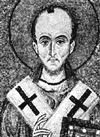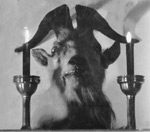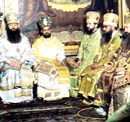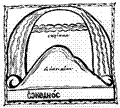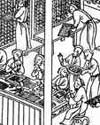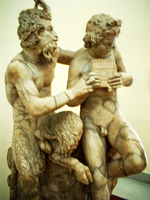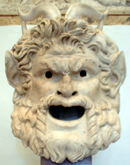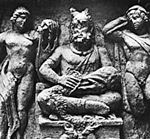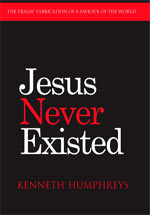Einstein
"I cannot imagine a God who rewards and punishes the objects of his creation, whose purposes are modeled after our own – a God, in short, who is but a reflection of human frailty.
Neither can I believe that the individual survives the death of his body, although feeble souls harbor such thoughts through fear or ridiculous egotism."
– Albert Einstein (New York Times, April 19, 1955)
And from a Church Father
"Pythagoras... practiced there ten thousand kinds of sorcery.... but by his magic tricks he deceived the foolish. And neglecting to teach men anything useful."
– St. John Chrysostom (344-408) "Homily II. John 1:1"
Hawking
"The quantum theory of gravity has opened up a new possibility ... there would be no singularities at which the laws of science broke down and no edge of space-time at which one would have to appeal to God ...
The universe would be completely self-contained and not affected by anything outside itself. It would neither be created nor destroyed ...
It would have neither beginning nor end: it would simply be. What place, then, for a creator?"
– Stephen Hawking, A Brief History of Time,136, 141.
And from a Church Father
"Tell me, what is the sense of this itch for idle speculation? What does it prove, this useless affection of a fastidious curiosity, notwithstanding the strong confidence of its assertions?
It is highly appropriate that Thales, while his eyes were roaming the heavens in astronomical observation, should have tumbled into a well.
This mishap may well serve to illustrate the fate of all who occupy themselves with the stupidities of philosophy."
– Tertullian (160-220) "De praescriptione haereticorum"
Devil "Made Up"
"For all the impious errors the Christians commit they show their greatest ignorance in making up a being opposed to God, and calling him 'devil,' or, in the Hebrew language, 'Satan' ...
It is blasphemy to say that the greatest God has an adversary who constrains his capacity to do good."
– Celsus, 2nd century pagan critic of the Christians (Pagels, The Origins of Satan, p141)
And from a Church Father
"...so poor is all the useful knowledge which is gathered from the books of the heathen when compared with the knowledge of Holy Scripture,
For whatever man may have learnt from other sources, if it is hurtful, it is there condemned; if it is useful, it is therein contained...
he will find there in much greater abundance things that are to be found nowhere else, but can be learnt only in the wonderful sublimity and wonderful simplicity of the Scriptures."
– St. Augustine (354-430), De Doctrina Christiana, 2,42 "Sacred Scripture Compared with Profane Authors"
It may not be science – but it IS colourful
Flat Earth?
About the year 300 AD Christian apologist Lucius Lactantius preached against Aristotle and in favour of a flat Earth:
"Those who defend these marvellous fictions, why all things do not fall into that lower part of the heaven ... they have once erred, consistently persevere in their folly, and defend one vain thing by another ... they either discuss philosophy for the sake of a jest, or purposely and knowingly undertake to defend falsehoods ... "– "Divinae institutiones, Book III - Of the False Wisdom of Philosophers."
Certain biblical passages implied support for the flat-earth view:
"And he shall set up an ensign for the nations, and shall assemble the outcasts of Israel, and gather together the dispersed of Judah from the four corners of the earth." – Isaiah 11:12.
"Again, the devil taketh him up into an exceeding high mountain, and sheweth him all the kingdoms of the world, and the glory of them." – Matthew 4:8.
Antipodes?
The possibility of people leaving on the other side of a spherical earth caused dire problems for a biblical history of humanity (descent from Adam? Noah's boat trip?)
Flat Earth?
"Cosmas Indicopleutes in the 6th century ... denounced the prevailing opinion that the earth was a sphere as being of pagan origin and contrary to plain good sense.
Instead, he maintained, the sky is draped like a tent over the flat, stationery earth and above it is another, heavenly, tabernacle inhabited by God and the angels."
– R. McKitterick, The Early Middle Ages, p217.
Cosmas was an Egyptian monk who reasoned (in his "Christian Topography") that the universe was a sort of house (on the plan of the Jewish tabernacle) with heaven as its upper story and the earth as its ground floor, with hell in the cellar. About it flowed four seas. and angels carried the stars in the firmament above.In truth, opinion about the shape of the earth divided both pagans and Christians. For most people, desperate simply to survive, the answer was irrelevant to their lives.
"Important Discoveries in Theology"!
Irish Archbishop James Usher (1580-1656), in charge of the project to write an English Bible "free of Popish errors", proved from Scripture that the world had been created on Tuesday, October 8, 4004 BC at 9:30 am !
Religious Stagnation
"The sciences of antiquity, whether physics, astronomy, medicine, or whatever ... were dominated by principles founded on human reasoning but which developed into a canon ... In the end Greek science failed because its adherents gave it the attributes of revealed religion.
The key figure is Aristotle ... Before science could begin to discover its true nature, Aristotle had to be dethroned."
– T. Crump, A Brief History of Science, p33/4.
"Never mind the books, grab the silk"
Two Nestorian monks were richly rewarded by Justinian I (527-565) for smuggling silkworm eggs out of China.
"I reflect with some pain that if the importers of silk had introduced the art of printing, already practiced by the Chinese, the comedies of Menander and the entire decads of Livy would have been perpetuated in the editions of the sixth century."
– Gibbon (Decline & Fall, 40)
The Chinese invented paper in the 2nd century BC. From the 2nd century AD classical Chinese literature was cut in stone slabs and thousands of copies were made by a simple printing technique.
Science and the Church
"Historically, the Church fought venomously against each new scientific advance. But after fruitlessly criticizing each new scientific achievement, the Church soon flip-flopped its position and embraced the new discovery as a 'gift from God to mankind.'
– David Mills, Science Shams & Bible Bloopers, p362.
“The Bible is not a textbook in science. Its world view is that of the childhood of the race, and this primitive cosmology is seen in all its references to the physical world.
The earth is conceived as flat and stationary. The sky is a canopy or vault through whose windows the rain falls. The sun, moon, and stars are contained within this vault. Beneath the earth is Sheol, the realm of the dead. The world and the creatures in it, according to the scripture, were made in six days.
The world in which the Bible was written was one in which human destiny was determined by the stars, sickness caused by demon possession, the dead were raised, angels stirred the waters of a pool for the healing of the sick, and the Red Sea was parted.”
– Bratton (A History of the Bible, p22)
At the center of the Christian Dark Ages stood the Bible. This fabricated compendium of garbled history, borrowed mythology, genocidal conflict and pious platitudes was elevated as the font of all wisdom, even as the bonfires set by Christian zealots reduced the science of a millennium to ash. In the new Christian tyranny all scientific thought which contradicted the Bible was suppressed. If rationality and observation contradicted the "revealed Word of God" then it was rationality and the observer who were in error.
St Paul himself had instructed his acolytes to "avoid profane and vain babblings, and oppositions of science falsely so called." (1 Timothy 6.20). In the new Christian commonwealth free thought itself was under seige. The Gathering Darkness In the early 340s a fanatic, Firmicus Maternus, wrote to the emperors Constantius and Constans ('De Errore'). He was one of the first Christians to urge the persecution of pagans, for which he promised the 'reward from God.' The monarchs needed little encouragement – persecution began immediately, with pagan sacrifice made a capital offence in 353. Recorded Gibbon:
Within a generation, the wildest dreams of Firmicus were fulfilled with the institution of the theocratic tyranny of Theodosius and the subsequent murder of scientists, the destruction of libraries, and eliminated and silencing of intellectuals.
A new and darker culture emerged. In 397, at the 4th Church Council of Carthage, the synod drew up a list of approved books of the Catholic canon and at the same time instituted a prohibition on anyone, including Christian bishops, from studying pagan literature. Non-Christian teachers, army officers, public employees and judges were dismissed from office. Early in the 5th century John Chrysostom (erstwhile patriarch in Constantinople) recorded with delight:
Within half a century, imperial edicts required the burning of non-Christian books. Many libraries of antiquity had been attached to temples, academies, and public baths and therefore suffered in the general attack by Christians on these vulgar pagan edifices. Plato's Academy, and the last of the pagan schools, were closed by Justinian in 529. In contrast to the assault upon science and paganism, imperial patronage and wealth from the elite poured into a plethora of new churches, monasteries and nunneries – glorifying God and securing for their patrons 'a place in heaven.' Starved of funds, as well as legality, scientific research inevitably withered and died.
End of Scientific MethodThe 'philosophy of the pagans' and secular public education were thus marginalised and eliminated. Lamented Ammianus Marcellinus, Rome's last great historian (who died in 395):
Initially, rhetoric and grammar remained on the syllabus but knowledge which did not serve the purposes of the Church was suppressed. Mathematics, with its historic link to the 'demonic' philosophy of the Pythagoreans, was especially suspect:
Such was Christian hostility to general learning and practical knowledge that access to scripture itself was forbidden to any lay-person who might still be literate. Preoccupied with ceremonial and holy pageants, within a few generations most members of the priesthood could not even read their own Bible. Ritual had replaced reading, iconography had replaced words. Scientific method – empirical observation of the natural world, the testing of hypotheses and revision of assumptions – had no role in an age in which eternal truth had been made known to man by the revealed Word of God.
The Natural World DemonizedIn this harsh and solemn world of Christ the rich variety of public entertainments of an earlier age were replaced by a meagre diet of pious ceremonials in which the Christian monarch and his retinue appeared ever-grander, ever more remote from mere mortals. (The emperor Hadrian had once been accosted by an old woman and chided for ignoring her petition; he read it. Christian monarchs could only be approached by courtiers, forced to prostrate themselves and kiss the hem of the imperial garments.) The frequent public holidays – more than half the year during the empire's golden age – disappeared with the gods they honoured. The pagan festivals had not only provided generous leisure time but had brought nature and the seasons into peoples lives. In the Christian monarchy 'Nature' was now seen as the domain of evil spirits, not a realm worthy of respect and exploration. Joyful public holidays were replaced by solemn commemorations of biblical events.
The popular nature gods of a millennium became the 'demons' of the Christians, infesting streams, forests, mountains and animals – and of course the temples and shrines of the pagans. The Christians, if anything, feared the old gods more than the pagans, particularly as they preferred a diabolic rather than a natural explanation for mishaps and disasters. Far from exposing the old gods as merely wood and stone (the fate of Serapis in Alexandria, for example), most Christians of the 4th and 5th centuries invested the pagan deities with a new, and sinister, power. Instead of contempt, now only the utter extirpation of the old gods could make the world safe for Christians.
God's DomainTo a plague of malevolent spirits was added the chastising hand of the Lord himself. Unlike the humanoid and capricious old gods of Greece or Rome – in the main, getting on with their own bawdy lives – the 'true God' of the Christians was pervasively interventionist, knowing every human thought, 'looking into men's hearts,' and able to suspend natural law at will. The course of nature could be anything that God chooses it to be; human 'knowledge' of natural causes could be overturned simply by God's decision to do things otherwise. In this brave New World Order, divine caprice and cosmic lawlessness had triumphed and rationality had died. All that remained was to glorify God and await his judgement.
Flight from Reality: Theology the Source of all 'Wisdom'As early as 221 AD the Bishop of Emmaus (in Palestine), Sextus Julius Africanus discovered that he could write a Christian 'history' by a close reading of scripture. His "Chronographiai" used the Bible to begin human history with creation in the year 5499 BC. His framework was used in the next century
by another, more notable fantasist, Eusebius, who
shamelessly declared:
Cartography takes a DetourWhether willfully or by neglect ancient understanding of world geography went into free fall with the emergence of the Christian theocracy. Ptolemy's 1st century "Geographica" – a handbook for Roman mariners (which not only promoted a spherical earth, but detailed the grid system of latitude and longitude still used today) – was lost to the west for well over a thousand years, as was the 2nd century "Periplus of the Erythraean Sea," which hints at knowledge of southeast Asia and China. In its place, Christian scribes developed theological maps which detailed such unlikely places as Heaven and Hell, and filled in the gaps with "terra incognito" and "here be dragons". Empiricism was unnecessary. Records one scholar:
Mapping the stars: What Did it matter?Mapping the stars was not an idle leisure activity. The lifeblood of Alexandria – as of other cities – was trade, particularly the export of grain and papyrus to the rest of the Mediterranean, and developments in astronomy allowed sailors to do away with the consultation of "oracles" and priests and be able to risk year-round navigation out of sight of the coast. As early as 300 BC Aristarchus had argued for a heliocentric theory, a sun-centred universe, though many thinkers continued to support an earlier Aristotelian system which had the Earth at the centre of several 'spheres' – despite various observed 'anomalies' in the movement of the planets. 400 years after Aristarchus, Ptolemy worked out a system of 'epicycles' to explain away the irregularities and maintain the geocentric, Aristotelian view. The Christians seized upon this Ptolemaic system with relish and their thinking never moved beyond that point. In the following centuries, mariners were forced, once more, to rely on "oracles" and the ship's Bible. Hazards of the sea consumed unfortunate sailors and, with so many cities in headlong decline, maritime trade collapsed. Banned by church, it was the rediscovery of the heliocentric theory by Copernicus which got Galileo into trouble in the 1600s.
In the New World Order – God's Manifest Magic
Sources:
|
|||||||||||||||||||||||||||||||||||||||||||||||||||||||||
|
|
|
||
|

